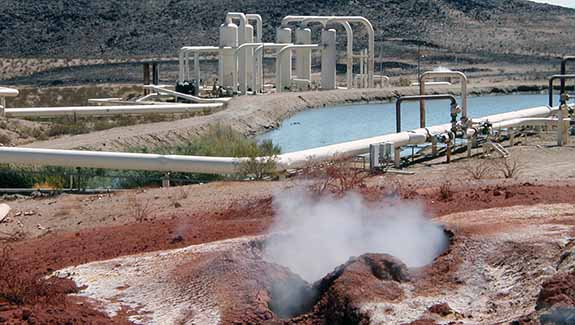Industry’s Hunger for Heat Drives Energy Demand
Study finds alternative thermal sources can satisfy industrial heat demand while addressing environmental concerns
August 2, 2019—Industry’s need for heat is driving fossil fuel demand and greenhouse gas (GHG) emissions in the industrial sector. Generally cited as the world’s largest GHG-emitting and energy consuming end-use sector, industry accounted for roughly 29% of global energy use in 2015, and 90% of industrial heat demand is met by fossil fuels. 36% of 2015’s global CO2 emissions was attributed to fuel combustion. This begs the question: How can industry generate the heat it needs while reducing its reliance on emissions-intensive fossil fuels?

A 2019 NREL/JISEA study suggests adopting alternative heat sources, such as geothermal, solar thermal, and small modular nuclear reactors, could cut industrial fossil-fuel use by nearly a third while lowering combustion greenhouse gas (GHG) emissions by nearly a quarter.
At the intersection of renewable electricity generation, nuclear electricity generation, and industrial systems, the analysis was performed at NREL under JISEA. Using GHG emissions and fuel-combustion data, NREL/JISEA researchers Colin A. McMillan and Mark Ruth conducted a top-down analysis of the 14 top-GHG-emitting industries in the United States. The study looked at heat requirements, combustion emissions, and the potential to produce heat from non-fossil sources.
The results, published in Applied Energy in April 2019, revealed these 14 industries, comprising less than 0.5% of all U.S. manufacturing facilities, accounted for 25% of the industrial sector emissions and 5% of total U.S. emissions in 2014.
But using alternative heat sources could have reduced their 2015 fossil-fuel consumption by about 31% and combustion GHG emissions by approximately 24%, according to the journal article, “ Using facility-level emissions data to estimate the technical potential of alternative thermal sources to meet industrial heat demand.“
Satisfying industry’s energy appetite
In the United States, process heating comprised 7% of total U.S. primary energy use and this figure is expected to grow in the years to come. In fact, the U.S. Energy Information Administration (EIA) projects industrial energy will grow faster than any end use sector and will comprise 37% of U.S. primary energy by 2050.
The researchers zeroed in on heat demands by industry, as well as by region. They found that 50% of heat demand was driven by the need to satisfy temperature requirements below 300°C.
The demand for process heat above 400°C was found to be the largest source of heat demand for the 14 target industries, accounting for nearly 33% of combustion fuel use.
Heat-swap savings
Based on heat requirements, researchers suggested three alternative sources of heat generation: geothermal, solar industrial process heat (SIPH), and small modular nuclear reactors (SMRs). They found that adoption of these sources would have reduced total fossil-fuel use by approximately 36% between 2010 and 2015. When broken down by energy source, SMRs would replace the greatest amount of fossil fuels, followed by SIPH technologies.
Paper mills (excluding newsprint) provide the largest source of relative fossil-fuel reductions with an alternative heat swap, coming in at approximately 97% in 2015. Petroleum refining topped the absolute fossil-fuel savings list.
Geographically speaking, the largest emissions reductions potential was found to be in Texas along the Gulf of Mexico, due to the petroleum refining and petrochemical manufacturing industries located there.
Meeting demands sustainably
The possible GHG emissions savings from these alternative heat sources is no small potatoes. Put into comparative terms, the aforementioned energy swaps in these 14 industries amounts to 5% of the total industrial-sector emissions, 5% of the total transportation emissions, and approximately 9% of the total commercial and residential emissions in 2015.
With the use of alternative thermal sources in place of fossil fuels, industry can meet its energy and heat demands sustainably.
Back to JISEA News >
